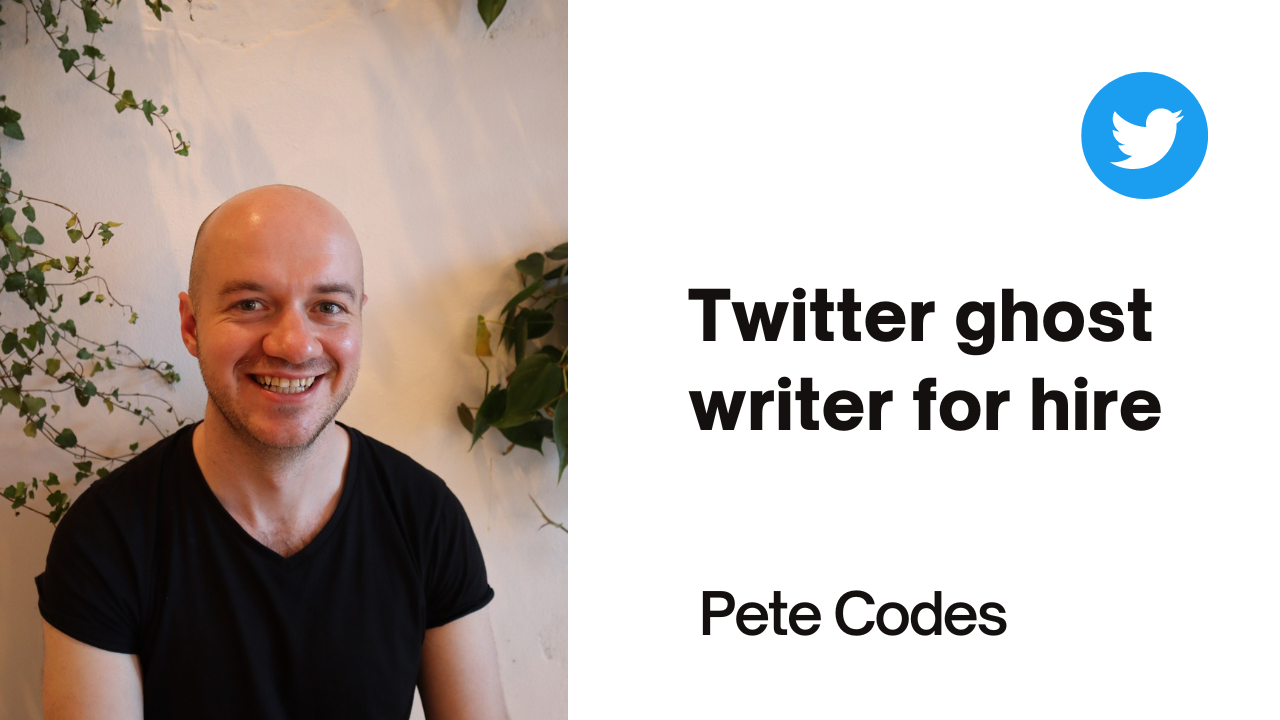Thankbox is a successful B2C bootstrapped website created by Valentin Hinov which is now doing $30-35k a month. Val saw an opportunity to create an e-card tool after witnessing the British culture of awkwardly passing cards around the office. Read on for Val's tips on building a B2C business, marketing and making a product people actually want.
Can you introduce yourself and Thankbox?
My name is Valentin Hinov and I’m originally from Bulgaria but now live in Edinburgh, Scotland. I started Thankbox in 2020 with my partner, Tsvetelina.
Thankbox is an online appreciation platform. At its core is a group card combined with a gift collection. It’s used mostly within businesses as a way to appreciate staff occasions - events like birthdays, farewells and retirements.
It makes it super easy to set up a card for someone and let the whole team add messages and contribute funds for a gift - people can add GIFs, videos & photos. Combined with our huge library of customisation options you end up with a really awesome looking card for any occasion.
Can you tell us what you’ve achieved with Thankbox?
Thankbox has been running for just over 4 years - we’ve just had our birthday last month in May. In that period it went from a side project to a full time business supporting a small team.
It’s currently making about $30-35k a month - there’s a lot of seasonality when it comes to card sending so some months are stronger than others. There’s also no MRR to track since none of our revenue is subscription-based. The business model is still very much B2C (business to consumer) with individual sales.
With that in mind, the metric I like to keep my eye on is the number of active users we’ve had over the last year. That’s a user who has made a purchase in the last 12 months.
It’s currently sitting at around 32,000 and getting higher each month. Thankbox relies on repeat purchases to get the most lifetime value per customer. The least amount of money someone can spend with us is $5.99 for a single card - ideally we want them to make several like that, eventually buying a pack of prepaid cards which can go for up to $299 for a pack of 100.
The last metric I’m really proud of is our gift card processing value - Thankbox currently processes nearly $500,000 of gifts every month on behalf of our customers.

What are some B2C advantages and disadvantages?
Funnily enough, before we started Thankbox with my partner I told myself to definitely avoid B2C startups but I guess I was bad at following my own advice!
B2C has a bad reputation amongst founders - both bootstrapped and venture-backed and with good reason. You need a lot of sales volume to achieve results. Customers can often be price-sensitive, even with a low-cost product. This makes it harder to raise prices - we’ve not raised ours once since we started! Also, if your UX isn’t super optimised then customer support can be outsized compared to the revenue you’re making.
It’s not all doom and gloom, though. Yes, you do rely on sales volume but it also means that you aren’t beholden to individual customers. If someone doesn’t like what Thankbox does, there’s millions more people that can be my customers instead.
When you have lots of customers plus a good product you get networking effects working for you. At least 30% of my new customers every month come recommended by someone else! It’s a very good flywheel I can rely on to keep bringing new people through the door every month.
B2C can also serve as a good entry point for a B2B model. For example, Thankbox is mainly used within business environments, where people send birthday, farewell or retirement cards to their staff. With that in mind, we are now trying to shift our positioning from being just an online card to instead thinking about Thankbox as an employee appreciation platform. That is a whole different offering where we can start talking and approaching business as customers. But those lessons only came after we ran exclusively as a B2C model for our first years.
Why did you decide to work on Thankbox?
Before working on Thankbox I spent 2 years building a social media app with no clear goal or direction - it never made any money or attracted investment. I knew nothing about startups and was just fumbling in the dark without a clear sense of what to do to get this thing off the ground.
Once that folded I told myself that whatever I end up doing next should only take a couple months to put together and it will be a paid product from the start. I immersed myself in bootstrapper culture and started learning more about how startups work. And, honestly, I just wanted to make some money online to prove I can do it - even if it was just $10.
I live in Britain where everyone in the office gives cards to each other for things like birthdays, someone working 10 years at the company or someone moving job. Everyone passes around the card and signs it but it was always a bit awkward, especially in small offices where it’s hard to keep it a surprise! Also, teammates working remotely can’t take part.
In late 2019 I decided there must be an easier way. I had a look and there were no solutions covering both cash collection for gifts as well as the message to the recipient. That’s when I realise, this is something I can make! My last startup had failed so I shared the idea with my wife (who is also my business partner). She loved the idea of an online service so we started to look into the idea more.
It wasn’t until Covid hit in March 2020, though, that we really decided to go for it. Everyone was going to work from home and it was a now-or-never moment. The first version of Thankbox went live two months later in May.

How did you first get people to check out the site?
I started tweeting about Thankbox and my partner and I started posting on LinkedIn as soon as the development kicked off in March 2020. We didn’t have huge followings but some people noticed it and became interested. A lot of them were office workers now stuck at home so they immediately related to the idea. A lot of the early traction was just from our personal network around Scotland.
We actually had our very first sale just an hour after launching! It’s a moment I’ll never forget - making my first £4.99 online!
For the first 6 months I knew where every single Thankbox customer came from because they were either people me or my partner knew or people that our contacts had recommended us to. It wasn’t making much money but the initial feedback was invaluable to help build out the core features the product needed.
Then, in late 2020 after giving our landing page a much-needed makeover we started running search ads and immediately saw an uptick. We went from selling 100 cards a month to 500 the next, to 1500 the one after that. Cheap PPC carried us through to about 2022 with fantastic growth almost every month.
We still use it as a channel now, but aren’t as reliant on it since the costs have risen astronomically and there’s much more competition. But it got the wheels of the business spinning and allowed us to find our feet with other channels - like SEO, which haven been a lot more reliable.
How long did it take to make the first version of Thankbox?
Only about two months! I actually had no website experience when I started it and was still doing contact dev work for clients at the time. My skills were mainly in mobile app development.
So I turned to a good friend of mine who had helped me with some web dev work before. He's a really solid full-stack developer who's done tons of freelance web work. We chatted about Thankbox and he offered to set up a profit sharing agreement in exchange for getting the first version off the ground.
We agreed that once Thankbox hits certain revenue milestones he'd get a share of the monthly profits for a year. This was great as it de-risked the whole project significantly for me - requiring a lot less upfront investment. I also knew that he would do an amazing job in setting up the initial stack.
We kept scope very very small - cutting features constantly until we were able to reach an MVP we felt comfortable launching with. It had lots of issues, yes, but the core of it was there - you could create a card, invite others to sign it and contribute money and send it to your recipient. That’s still the core of our product today, even though it does plenty more than that.
What tips do you have for making money with one-time purchases?
If you’re going to be playing the volume game then make your product as self-serve as possible. Most customers should never have to contact you to figure stuff out. We’ve spent countless hours optimising the full flow - from creating a Thankbox, to sharing it with others, to sending it to be as straightforward as possible. We must be doing something right because half of our 500+ Trustpilot reviews mention the word “easy” in them.
Also - automate, automate, automate. We process thousands of transactions each day - people buying Thankboxes, people adding money to Thankboxes and recipients claiming their gift cards. All of that needs to be tracked and records kept for bookkeeping, funds security & fraud prevention. We’ve invested a lot of time in automating as much of this as possible - down to generating automated Excel reports and auto-populating Xero. Honestly, the business model wouldn’t even be viable if we hadn’t. Thank goodness Stripe has great APIs!
When you’re dealing with many small individual transactions, payment processing fees can take a huge cut of your revenue. To illustrate the point - we charge contributors to a Thankbox gift card pot a small fee to leave money (for example, to leave $10 we charge $0.48) and that helps us offset part of our processing fees. If we didn’t do that then we couldn’t offer gift collections as a service as the Stripe fees would end up costing us more than we’d make from the Thankbox sale.
What is a mistake you see a lot of first-time founders making?
Not talking to their customers. Not even knowing who their customers are. I was actually talking to a friend of mine recently who shared his new startup idea with me. He spent 20 minutes talking about how great his product will work, how technically advanced it’ll be. But not once did he mention where he’ll find his first customers. It’s easy to get excited about building but you should always start with your customer first.
Even though we have hundreds of new customers per day we still send a welcome email to every one of them. We ask them for feedback on Thankbox after they send their first one. And I still personally reply to every single response we get - which can be 10+ a day! This keeps me in touch with what customers need, why they picked us and what we can improve. It’s also a great way to build rapport with customers in an experience which is otherwise very self-serve.
I also send LinkedIn invites every month to some of our top customers - those who buy cards regularly or buy our bigger team-focused packs. I do my best to stay connected with who our customers actually are - not who I think they are.
Can you talk about what tech you use for Thankbox?
Thankbox is built on Laravel - the most widely used PHP web framework. I love Laravel because it has a ton of first and third-party packages - both free and paid. This has saved me a ton of time rather than building stuff myself. The support is great and the community is huge and most importantly Github Copilot understands it very well!
The frontend is mostly Vue.js with Typescript and Tailwind - also a pretty standard, non-complicated combo and that’s the way I like it. It allows me to move fast and it’s easy to hire for - which I’ve found to be very valuable now that we have 3 developers working on the codebase.
Where can people find out more about you and Thankbox?
You can find more about Thankbox at https://www.thankbox.com. You can follow me on my LinkedIn or Twitter, though I’ve been more active on LinkedIn recently.


